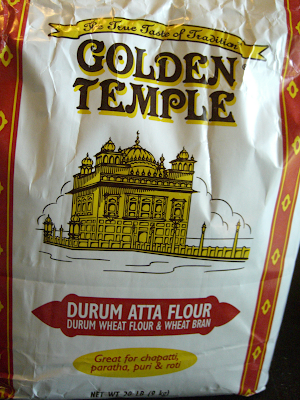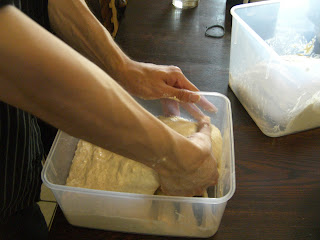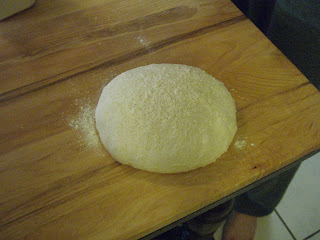My sourdough starter is a varient of Chad Robertson's tartine sourdough starter. It is characterized by daily feedings, no refrigeration, and volume on order 50 mL (3 tbspn) or order 60 g. Here, I present a quick guide to sourdough starter. For an objectively superior guide, see Francis-Olive.
If you have difficulty, try Pineapple.
Instructions:
Ingredients / Tools:
- Whole wheat flour
- Filtered / bottled water
- Clean glass container
- Spoon
- Scale
1. Creating a Sourdough Starter
This took me over two weeks to compete. Your patience will be rewarded.
- Pour 20-40 g water into the clean glass container. A jar works very well.
- Pour equal amount by mass of flour. Mix well.
- Lightly cover with towel or paper towel and place in a warm but not hot place (75-80 F is perfect). I placed it on top of a refrigerator.
- Wait 2-3 days. The mixture should smell a little ripe and bubbles should form on the outside. If neither occurs, let it sit for another day or two.
- Discard most of the starter (Chad Robertson advises 80%) and replace with equal parts water and flour until you reach the same level.
- Repeat steps 3 through 5 until the starter "rises and falls".
- Rises and falls implies the volume of the starter should at least double, then fall back to the same level.
- Once you have a starter that rises and falls reliably and smells sour, tangy and burns your nose if you sniff it when you first open the jar (like wasabi), you can start making a levain.
2. Feeding a Sourdough Starter
I do this every day. It takes less than 2 minutes if everything is set up.
- Feed your starter when it has fallen (gone back to the original volume. If you feed too early, your starter will lack the speed and force that you desire. You would need to wait longer for the next feeding. If you need to feed earlier, leave more of the original starter.
- Remove most of the starter and discard. Most implies over 90%.
- Replace the removed starter with equal parts water and flour. Mix well. It should form a thick paste. The texture is similar to pudding with chunks. I keep my starter as liquidy as possible while still holding a peak after I stop stirring.
- Wait 16-24 hours.
- Feed more often when it is warmer.
- Feed more often if you use white flour or wheat flour without as much bran or other complex starches
- Glass works best for the starter. Chad Robertson says that plastic tubs are okay. My plastic ones did not start growing until a few days after my glass ones. I started my glass ones after the plastic ones.
- Place the starter in a warm place if you want to have more activity. Placing them in a cool (shaded) place will slow them down slightly
- I have placed starters in a refrigerator for 3 weeks and revived the starter successfully. It takes 2-3 days before the starter wakes up and is able to produce bread. I like to discard only 75-80% of the starter when I try and wake it up.
- WARNING! Do not leave your starter mostly empty for extended periods (>6 hr). I left mine at around 10% of normal for half a day and it took over a week of daily feedings to recover.
If you have difficulty creating a starter, read the Pineapple juice trick linked at the top. I used a variant of that to create my first starter. I happened to have pure citric acid on hand. It must have been the right kind because my starter activated a few days after I treated my starter with citric acid.
If you want to see what a sourdough starter looks like in a warm environment, see Francis-Olive's Tartine bread experiment at the top. My starters never look as active as hers. My levains resemble her starters at times.
Do not be disappointed if your starters are not as strong as those you see on the Internet. Mine took almost 8 months to produce good bread. It still does not froth or foam as much as other peoples' starters.

















































